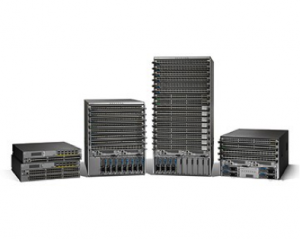Cisco has a broad base of data center customers with a diverse set of requirements and we meet their needs with Nexus – the most comprehensive switching portfolio in the industry. This week, we are making announcements for both the Nexus 9000 series and the Nexus 3000 series that provide design and deployment flexibility for our commercial, enterprise, service provider, as well as cloud customers. Key points of the announcement include:
- ACI (Application Centric Infrastructure) is shipping this month;
- Additional linecard and chassis options provide customer choice and flexibility;
- 100G linecards for the Nexus 9500 will be available in Q4CY14 and will offer the highest density in the industry; and
- New starter kits and bundles help customers ease transitions.

The Nexus 9000 Series
ACI is shipping this month
The Nexus 9000 series can operate in standard NX-OS mode or in ACI mode. In either case the Nexus 9000 portfolio delivers the value of the “5 P’s” of Power efficiency, Price, Port density, Performance, and Programmability. NX-OS mode provides customers with the value of the NX-OS operating system used by tens of thousands of customers in data centers around the world. ACI mode adds to NX-OS capabilities by providing an application driven policy model, integration of hardware and software, and centralized visibility, among other things. ACI requires a controller and switch software. Both are shipping this month. It is important to note that the pricing for this solution is simple and predictable. There is a perpetual license for each leaf switch. Other pricing approaches in the industry are monthly and are based on varying elements like number of VM’s. Comparing the two approaches is somewhat like comparing a cell phone bill that is either flat rate or usage based. Personally, I like the simplicity and predictability of flat rate. See The Future of Networking, as well as SDN and Beyond for additional details on new ACI announcements and how they can take you beyond SDN.
Additional linecard and chassis options underscore flexibility
We’ll consider how flexibility is delivered for both modular and fixed platforms. For modular switching, the Nexus 9500 modular chassis family offers different line card options that can be mixed in the same chassis and allow customers to “dial up” or “dial down” their design based upon the price, performance, feature set, and scale they want to achieve. There are basically 3 different ‘flavors’, all of which are now shipping:
- The Nexus 9500 X9400 set of 1/10G and 40G line cards are based on merchant silicon and provide industry-leading price and performance compared to other merchant silicon switches. These provide a very cost effective solution ideal for traditional modular data center designs.
- The Nexus 9500 X9500 set of 1/10G and 40G line cards are sometimes referred to as “merchant plus” because they have custom Cisco ASICs, in addition to merchant silicon, and are ideal for customers that need performance together with additional buffering and VXLAN routing capabilities. The X9500 line cards can be used in future ACI designs as well.
- The Nexus 9500 X9600 set of 40G line cards provide performance without compromise even for small packet sizes.
The Nexus 9300 series offers ACI capabilities (ala the X9500 linecards in item 2 above) in a fixed form factor. For customers interested in a merchant only fixed form factor, we offer the Nexus 3000 family. This week, we announced the new Nexus 3164, which provides 64 ports of 40G and is a great solution for 40G access or space constrained aggregation.
100G linecards
We are also announcing 100G linecards that we believe will deliver industry leading port density of up to 128 ports of 100G in a single chassis. 100G for both the X9400 and X9600 series will be available for the Nexus 9500 in Q4CY14. Cisco will offer an 8 port 100G X9400 line card and a 12 port 100G X9600 line card.
New starter kits and bundles ease transitions
There are numerous packages available to ease transitions – from 1G to 10G, 10G to 40G, or from traditional networks to ACI. There are 2 bundles I want to quickly call out. The first provides a smooth transition for customers with older End of Row Catalyst 6500’s in their data centers. It occupies the same rack space and uses the same cabling as they currently have, but provides 10X the performance. The second is basically an ACI starter kit, providing the APIC, spine switches and leaf switches, even optical cables – everything required to set up and get started with an ACI pod.
In summary, Cisco is continuing its rapid pace of innovation and execution around ACI and data center switching overall. Ultimately, this means customers gain choice, flexibility and true innovation to support their business needs.
CONNECT WITH US